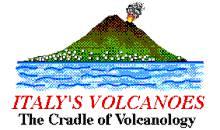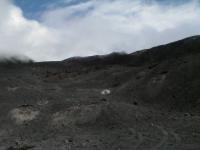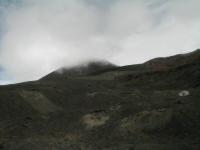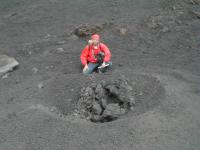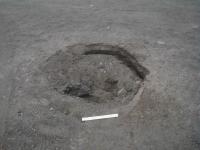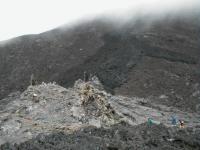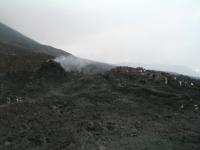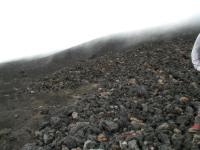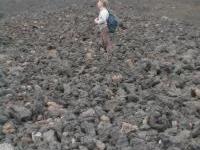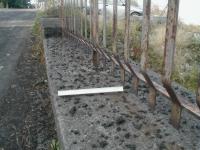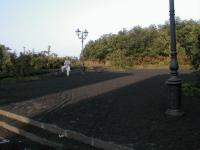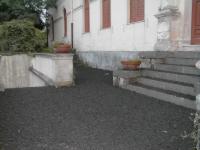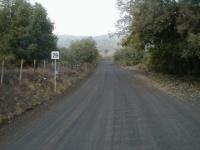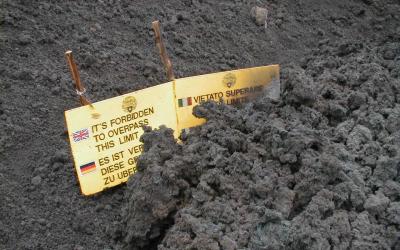
A lava flow of 4
September 1999 from the Southeast Cone stopped right at the sign warning
to proceed further
|
WARNING: Access to the
summit craters is VERY DANGEROUS.
Strong explosive activity may occur at all four summit craters,
and visitors should not go to their rims or anywhere close to
the craters. Besides this, weather conditions are often unstable,
even during the summer; summit visitors may be surprised by
snowstorms (as occurred on 24 July 1999) or thunderstorms: one
man was killed by lightning at about 2000 m elevation near Piano
Provenzana on 30 August. Any person who enters the area beyond
the Torre del Filosofo mountain hut (2900 m elevation) or the
hut of the guides on the northern flank (Baita delle guide,
3000 m elevation) goes at his/her own risk and is not covered
by any insurance in case a rescue operation (e.g., with helicopters)
is necessary.
|
21 September update.
Eruptive activity is continuing at Etna's summit
craters, and lava continues to flow from the eruptive fracture first
observed on 12 September. During the early morning hours of 20 September,
an episode of lava fountaining occurred at the Bocca Nuova, but this
was much less intense than the 4 September eruptive episode at the
Voragine. Strombolian activity in the summit area (the precise location
of this activity was not identified) was observed in the evening of
20 September from Nicolosi on the southern flank of the volcano.
Observations of the activity,
11-12 September. The following information,
provided by Giuseppe Scarpinati (Italian correspondent of the French
Association Volcanologique Européenne (LAVE) on 13 September,
is based on a summit visit made on 11-12 September. Scarpinati did
not see much of the summit craters due to bad weather, but he had
the possibility to visit the area of effusive activity near the Southeast
Cone repeatedly on the evening of 11 September and early the next
morning.
On the late afternoon of 11 September, effusive activity near the
large spatter cone formed since 27 August was limited to what Scarpinati
called "residual activity", that is very little lava emission
and no pyroclastic activity. However, during the evening it became
evident that lava was flowing from an area about 200-250 m further
downslope to the east, and there was also minor lava spattering in
that area. Near the 27 August spatter cone Scarpinati heard ominous
noises (similar to those heard on 12 May just before the collapse
of a large lava tumulus on the western slope of the Valle del Bove),
but nothing else happened.
The next morning at about 0700 h (local time=GMT+2), lava was again
flowing from vents immediately below the 27 August spatter cone. One
relatively large flow advanced about 70 m towards east-northeast,
while two smaller flows moved only a few meters to a few tens of meters;
the smaller of these two flows "was moving like toothpaste".
Scarpinati then walked around the 27 August cone towards north and
then turned east, descending into the direction of the Valle del Bove,
and about 200-250 m east of the 27 August cone there was a new spatter
cone (or rather a double spatter cone, with a smaller one standing
within the vent of the larger one) that was actively ejecting small
fragments of lava. Fluid lava issued (from a vent near the cone?)
at a rate estimated at at least one cubic meter per second, forming
a well-fed flow that moved along the margin of the flow-field formed
during the past months. The intensity of pyroclastic ejections from
the spatter cone increased gradually, and by 1000 h, somewhat larger
blobs of lava were ejected about 5-6 m high, falling in a radius of
several meters around the vent.
The new eruptive vents have become active on a terrain not covered
by lavas during the last months, and it appears that this is a true
new eruptive fissure. This means that the activity has migrated downslope,
a process that has also been common at the Northeast Crater during
its long-lived eruptions in the 1950's to 1970's, and this has nothing
much to do with a flank eruption. However, the opening of new vents
farther away from the Southeast Cone points to an increasing structural
instability of the area.
The Voragine eruption of 4
September 1999: eyewitness accounts and field observations.
On the late afternoon of 4 September 1999, the
Voragine, one of Etna's four active summit craters, produced a powerful
eruptive episode which may have been among the three most vigorous
eruptive events at Etna during the past 100 years. As of 10 September,
eruptive activity is continuing at lower levels in the Voragine, the
Bocca Nuova, and at the southeastern base of the Southeast Cone. The
following report consists of four sections: the first covering the
activity during August and the first days of September, the second
dealing with the events of 4 September, the third describing field
observations made after the eruption, and the fourth summarizing the
few observations of activity since 4 September.
Activity between late-July and 3 September
1999. Axel Timm from Germany visited Etna on 15 and 16
August and made the following observations. There was little activity
in the Bocca Nuova on 15 August, with quiet degassing at the northeastern
vent, while dilute ash clouds were emitted at intervals of several
hours from the southeastern vent. In the Voragine there was only gas
emission from the "diaframma vent", but minor eruptions
occurred at intervals of 5-60 minutes from the central vent, allowing
a descent into the crater. Rumbling noise came from deep within the
central pit of the Northeast Crater, but dense gas emission prevented
a view of the pit's interior. The Southeast Crater was completely
quiet. Several small lava flows issued from the area of the hornitos
at the upper end of the 4 February fissure at the southeastern base
of the Southeast Cone.
On 16 August, occasional rumbling sounds came from the northeastern
vent of the Bocca Nuova, while the southeastern vent continued to
emit ash to 50-100 m above the vent at intervals of about 30 minutes
without any noise. The "diaframma vent" of the Voragine
was inactive, and eruptions occurred every 10-30 minutes from the
central vent; these eruptions varied from noisy gas emissions to explosions
that ejected bombs and scoriae far beyond the rim of the vent, mostly
towards north. Activity at the Northeast Crater was similar to that
observed on the day before. At the 4 February fissure, several active
lava flows were visible, the largest of which was about 2 m wide and
was flowing relatively fast, while all the others were much slower.
The following information about activity in the summit area was provided
by e-mail on 31 August by Claude Grandpey, of the French Association
Volcanologique Européenne (LAVE). Modifications to the original
text are set in brackets [].
"Before [...] 20 August, there had been a strong decrease in
the emission of lava [from the 4 Februar fissure] and only one flow
was visible on the eruptive site. This fact was confirmed during my
first visit on 24 August. The lava flow was about ten meters long
and 40 cm wide and quite slow. It was located about 30 meters to the
south of the February hornitos and flowing toward the SE crater. The
lava was just fluid enough for the [mountain guides] to make ashtrays.
It stopped in the afternoon and about one hour later, the tumulus
from which it originated started cracking on the eastern side and
a new flow appeared. It went along over ten meters and stopped [...].
I went back to the site the next morning (25 August) at 9 o'clock.
A very small flow (about 50 cm long) was still escaping from the same
tumulus, but at ten it was all over and since that time, [no further
effusive activity has occurred].
"[The end of the effusive activity]
corresponds with a strong increase of the activity inside the Voragine.
When I arrived at Zafferana on 23 August, my friends told me that
the volcano had been noisy during the night. I climbed the NE Crater
on 24 August in order to have a general and safe view of the activity.
The explosions were very irregular and the materials were ejected
from 2 small vents situated on the northern rim of the ["diaframma
vent"]. The ejecta were sent flying very high in the sky and
some of them were falling on the outer western slope of the Voragine
and very close to the base of the NE Crater. I was told by the guides
at the Torre del Filosofo that their colleagues had stopped taking
the tourists to the rim of Bocca Nuova because of the obvious danger.
As clouds covered the summit later in the afternoon, I stopped my
observations on that day. [...] As the activity was less strong at
that time [I and a group of other volcanologists including three from
the universities of Southampton and Portsmouth] decided to walk into
the crater and go to the edge of the terrace that is accessible from
the foot of the NE Crater. We saw and heard occasional explosions
but the most interesting fact was a small lava pond about 5 meters
in diameter in a small vent near the ["diaframma vent"].
The lava was very fluid and spattering and a small flow even escaped
from the pond for some time. The activity of the pond lasted one hour
or so and then the lava began going down inside the vent until it
was no longer visible. I then decided to go up to the western rim
to have a better view of it but the lava was hardly visible any longer.
While I was standing on the rim, I suddenly saw the central part of
the Voragine inflate over a surface about 50 meters in diameter [...].
A few seconds later, there was a first explosion - not very strong
- that sent about half of that [domed area] flying toward the south
and the "diaframma". I then decided to leave that place
and walk down toward the Bocca Nuova, [expecting] another explosion.
It happened at the very moment I reached the rim of Bocca Nuova. It
was very very strong and noisy - like the noise of a cannon - and
sent the bombs flying as far as the inside of BN and above all all
over the western slope of the Voragine. There were other similar explosions
during the rest of the day and the next day. I re-visited Bocca Nuova
and the Voragine on 27 August. There was a new cavity - not very deep
- at the center of the Voragine and explosions were projecting materials
from one of the small vents near the ["diaframma vent"]."
Grandpey observed no eruptive activity at the
SE Crater during the days of his visit, but "gas, steam and powder
were coming out of the NE Crater with a loud rumbling at the bottom
of the vent." No morphological changes had occurred there since
late July. Bocca Nuova was relatively quiet, the southeastern eruptive
vent emitting clouds of gas with little noise.
The cessation of effusive activity from the 4 February fissure on
25 August was followed two days later by the opening of a new fissure,
about 50 m long, and located some 40-50 m to the north of the cluster
of hornitos at the upper end of the 4 February fissure. Mild Strombolian
activity during the following days built a large spatter cone
up to 8 m high (oral information from Giuseppe Scarpinati), and lava
began to flow towards the Valle del Bove along the northern rim of
the voluminous lava field emplaced between 4 February and late August.
This lava flow appears to have been fairly small; Scarpinati observed
a "small incandescent spot below the Southeast Cone" when
watching the mountain from his home in Acireale on the evening of
1 September. Bad weather precluded observations on 2 and 3 September.
The 4 September 1999
paroxysm. Press reports indicate that volcanic tremor began
to register on seismographs on the volcano during the early afternoon
of 4 September, but bad weather made visual observations impossible.
Nontheless Giuseppe Scarpinati and several mountain guides as well
as a group of excursionists were near the Torre del Filosofo mountain
hut (located at about 2900 m elevation, and about 1 km south of the
Southeast Crater) during the afternoon and began to hear a hissing
sound at about 1730 h (local time=GMT+2). This sound was distinctly
audible in spite of the strong wind, and gradually became stronger,
until it was "similar to the noise of a starting jumbo jet".
Soon afterwards Scarpinati and his companions heard the crashing noise
of impacting blocks and bombs at some distance, and they began to
retreat towards the Torre del Filosofo mountain hut and later to the
top station of the cable car (at about 2400 m elevation), where they
waited to obtain a clear view of the summit area. As it got dark,
the noise of the eruption became lower, and when most of the event
seemed to be over (that is, between 1930 and 1945 h), the cloud cover
lifted for a brief period. Scarpinati reports that before his eyes
"the whole summit cone was aglow", as it was covered with
still-incandescent ejecta from the Voragine. A few moments later,
"the largest explosion I have ever seen" (citation from
Scarpinati who has climbed Etna about 500 times during the past 35
years) occurred from the Voragine. Huge incandescent bombs were ejected
in a broad fan over the summit cone, crashing onto its flanks and
rolling downslope to its base.
Some time later, at about 2030, the summit vent of the Southeast Cone,
inactive since 4 February, began to produce Strombolian explosions.
This activity had nothing in common with the paroxysms that had occurred
at the same vent between September 1998 and 4 February, but was "like
the usual Strombolian activity" that had been characteristic
of the period between late-1996 and July 1998. Scarpinati and his
companions left the area after some time, when the activity continued
in the same manner. However, later that evening, lava began to issue
from the lower part of the fracture that had been active on the southeastern
flank of the Southeast Cone during a late stage of the 4 February
eruptive episode (see the February 1999 updates listed in the column
at left), and the output from the effusive vents at the fissure of
27 August increased, with lava flowing rapidly towards the western
rim of the Valle del Bove.
While the activity initiated that evening at the Southeast Cone was
relatively mild, the paroxysmal eruption from the Voragine a few hours
earlier had widespread effects. Soon after the beginning of the eruption
in the afternoon, loud detonations were audible in villages and towns
around the volcano, reminding people of an "air attack".
This was followed by a fall of scoriaceous lapilli on the eastern
flank, extending to the coast near the town of Giarre, more than 15
km from the summit. Many of the lapilli were walnut-sized, and some
had a diameter exceeding 5 cm. Eyewitnesses reported that some of
the larger fragments were still hot when falling near the villages
of Milo, Fornazzo and Sant'Alfio, but not hot enough to set vegetation
afire. The impact of the larger clasts broke the windshields of many
cars and seriously damaged vineyards and fruit gardens. In a narrow
sector extending from the Milo-Fornazzo area towards the coastal strip
near Giarre, the pyroclastic deposit was several centimeters thick,
and traffic was disrupted due to the layer of scoriae on roads and
on the Messina-Catania highway. Press reports put the damage caused
to the agriculture and to the local infrastructure at several tens
of billions of Lire (several tens of millions of US $). According
to the Catania-based newspaper "La Sicilia", about one million
cubic meters of pyroclastics fell on the town of Giarre alone.
Field
observations, 6-8 September. The following is based on
field investigations made by Boris Behncke (Dipartimento di Scienze
Geologiche of Catania University) and Werner Keller (co-authors of
the web site "Chile's
Volcanoes") in the area of Milo, Fornazzo and Giarre on 6-8
September, and during a summit visit on 7 September. Measurements
were made of the thickness of the deposit in various locations before
heavy rainfalls swept part of it away, and when the cleaning of roads
was still in an initial stage.
During the visit to the summit area on the afternoon of 7 September,
visibility was hampered by dense clouds, but the effects of the eruption
near the summit craters were seen to be striking. The cones of the
summit craters were hit by countless bombs up to 5 m in largest diameter
and lithic blocks up to 1 m across, most of which had created spectacular
impact craters. The largest of these craters were more than 5 m across.
Many bombs and some blocks had fragmented upon impact, others were
found outside the craters created by their impact up to 10 m away
(in the direction away from the Voragine). In many instances the projectiles
had obviously arrived on a fairly flat trajectory, others had pierced
the ground vertically. The density of large bombs and blocks was particularly
high on the southwestern flank of the main summit cone. Some of the
larger bombs were still warm to the touch (but not hot) about 60 hours
after their emplacement.
A peculiar phenomenon was observed on the southern flank of the main
summit cone. Here the accumulation of juvenile scoriaceous pyroclastics
had apparently been so rapid that the deposit began to slide down
the steep flank, forming something like a dry debris flow that extended
about 500 m down the slope to its base. In its distal portion the
flow ends in two distinct lobes about 1 m thick. About 80 per cent
of this deposit consists of juvenile clasts 10-30 cm in diameter whose
edges were rounded while sliding down the slope, the other 20 per
cent are older clasts (reddish scoriae and gray lithic blocks) whose
diameters are slightly less than those of the juvenile clasts. This
dry debris flow deposit is different from anything seen in ten years
of frequent visits to Etna's summit area by Behncke, and is striking
evidence of the dynamics of the 4 September event.
Brief glimpses through the clouds permitted a view on the Voragine
from a place about 500 m west of the crater rim. The heavy fallout
close to the crater almost healed the large scar cut into the southern
flank of the adjacent Northeast Cone. On the southwestern crater rim
(close to the Bocca Nuova), the rapid accumulation of fluid ejecta
led to the formation of a rootless lava flow, very similar in appearance
to the flow formed during the 22 July 1998 eruption from the same
crater, but this new one was broader (about 300 m) and about half
as long (250-300 m). A similar but smaller flow was reported by Scarpinati
(who visited the summit area the morning after the eruption) on the
eastern side of the Voragine; this area was not seen during the 7
September visit. Reports by mountain guides at Piano Provenzana on
the northern flank of Etna indicate that yet another lava flow cascaded
into the adjacent Bocca Nuova, but some reports received during the
days after the 4 September eruption saying that the Bocca Nuova was
largely filled by products coming from the Voragine appear to be vastly
exaggerated. According to the same guides the Bocca Nuova looks "much
the same as before, except for the new lava flow".
On the eastern flank the lapilli deposit extends in a narrow strip
almost due east towards the coast near Giarre. Five communities (including
Milo, Mascali and Giarre) suffered heavily from the fallout. Going
northwards from Zafferana, on the southeastern flank, the southern
margin of the fall deposit is encountered in the forests between the
small village of Petrulli (about 2 km north of the center of Zafferana)
and Milo, the next village to the north, where isolated scoriaceous
lapilli with diameters between 1 and 3 cm occur. Closer to Milo (1.5
km further north) the number of clasts per square meter increases
as well as their mean diameter, and on the southern margin of the
village the deposit becomes continuous. Most of the deposit consists
of lapilli-size scoriae, with little ash mostly coating leaves and
grass. The largest clasts found in the southern part of Milo were
7 cm across, and many were 5 cm large. In the northern part of Milo,
the thickness of the deposit exceeds 5 cm, and many leaves (mainly
vine grape plants) were damaged by the fall; some show evidence of
heat.
In the southern part of the village of Fornazzo, about 1.5 km from
Milo, the deposit is 5-6 cm thick, and the largest clasts are up to
10 cm across. Residents reported that even larger clasts fell, but
fragmented upon impact. Going further north, the deposit thins gradually
and ends with a relatively sharp margin about 2 km north of Fornazzo.
Further downslope, near the town of Giarre, the area of fallout is
about 5 km wide in north-south extension, and up to 5 cm thick in
its central portion. Most of the deposit here is composed of fragments
with diameters between a few millimeters and 3 cm. The northern and
southern margins of the deposit are strikingly sharp, it seems that
very little and only fine ash fell beyond the margins of the lapilli
deposit.
Comparison with the (relatively poor) descriptions of the fall deposit
produced by a violent eruption from the Voragine on 17 July 1960 allows
the conclusion that the 4 September 1999 eruption was of similar proportions,
and therefore it was among the three largest explosive eruptions at
Etna's summit craters during the past 100 years. The 1960 eruption
produced about 10 million cubic meters of pyroclastics; the pyroclastic
deposit then extended northeastwards in a somewhat broader sector,
and clasts more than 5 cm in diameter were reported at that time.
Different from the 1960 eruption, the 4 September 1999 event did not
cause fires in the forests on the flanks of the volcano, but this
may be only due to the fact that it was raining at the time of the
eruption or shortly before. In any case this new event was significantly
larger than the 22 July 1998 eruption from the Voragine.
The activity of the Southeast Cone on the evening of 4 September had
much minor effects. The most impressive change since the last visit
by Behncke on 28 July was the presence of a small lava flow that had
issued from the lower part of the fracture active during the 4 February
eruptive episode on the southeastern flank of the cone. The flow extended
to the hornitos at the upper end of the fissure which emitted lava
between 4 February and 25 August, with a small lobe extending eastwards
from the main lobe. The main lobe filled a small depression near the
hornitos and stopped at a sign saying "It is forbidden to overpass
this limit".
Eruptive activity since 4 September.
During the past 6 days, eruptive activity has continued at the summit
craters, but visual observations have been seriously hampered by bad
weather. Intense explosive activity has occurred on each day at the
Bocca Nuova, and at times bombs were ejected onto the outer slopes
of the main summit cone, mainly towards west. The Voragine has remained
active as well, and another episode of vigorous activity occurred
shortly after midnight on 9 September. There are no eyewitness accounts
of that event, but intense seismicity indicates that the most intense
activity occurred between 0100 and 0400 h on 9 September; this may
have consisted of lava fountaining. This event, however, was significantly
smaller than the 4 September eruption, and there were no reports of
new tephra falls in inhabited areas around the volcano. During their
summit visit on 7 September, Behncke and Keller reached the area of
effusive activity and saw two small lava flows issuing from effusive
vents located some 15 m below the spatter cone formed during the days
after 27 August. The flows have remained active since, and are extending
onto the western slope of the Valle del Bove. Mild Strombolian activity
is occurring from a new cluster of hornitos located near the effusive
vents. This activity is similar to the mainly effusive activity between
4 February and 25 August.

visitors counted since 12 February 1999
(more than 10,000 during the first 3 weeks!)
FastCounter
by LinkExchange
Page set up on 27 May 1997, last modified
on 21 September 1999

